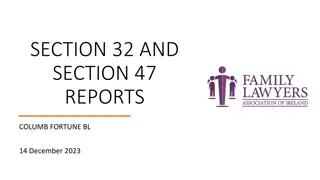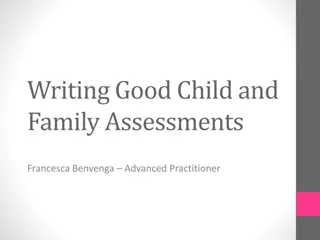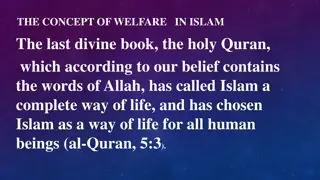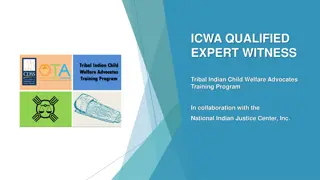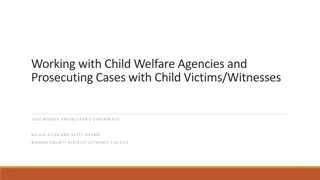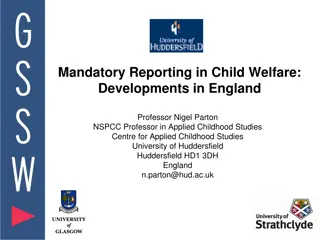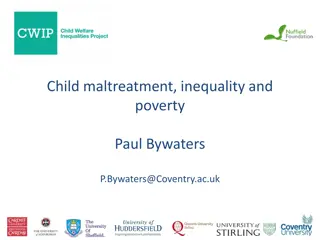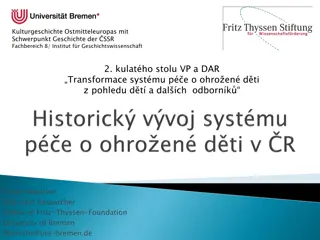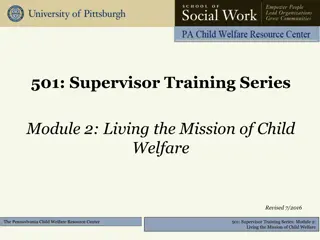Evolution of Child Welfare: A Historical Perspective in India
Governments in the past neglected child welfare, considering children as invisible entities. However, there was a shift towards recognizing the importance of caring for children globally. Initiatives like orphanages and child protection laws emerged over centuries, with notable developments in France during the 17th century. Efforts to address child exploitation and abuse during the industrial revolution led to the establishment of institutions to safeguard children's rights.
Download Presentation

Please find below an Image/Link to download the presentation.
The content on the website is provided AS IS for your information and personal use only. It may not be sold, licensed, or shared on other websites without obtaining consent from the author. Download presentation by click this link. If you encounter any issues during the download, it is possible that the publisher has removed the file from their server.
E N D
Presentation Transcript
Historical Review of Child Welfare in India Mr. Vijay Sansare Assistant Professor
The governments of the bygone era did not consider child welfare as a part of their agenda as children were invisible entities. Children were considered adults and were required themselves in the adult world. Individual and religious organisations rather than the governments importance of childhood and undertook to preserve it by providing welfare. as miniature fend to for realised the Introduction
Thereafter, world community recognised the need to take care of the child and today it has emerged at the centre of public concern almost all over the world. Leaders and statesman in all parts of the world have begun to identify themselves with family and children s issues (Black 1996). the governments and the Introduction
The earliest known form of service to the needy children began attached to early monasteries in Catholic or Islamic countries, the oldest of which may probably have been orphanage in the Iranian Mosque of Holy Shrine at Meshad (Baig 1979). There were no cr ches, nursery schools or children s hospitals and everything related to children was considered responsibility of the mother and the family. with orphanages the 9th century to be the International Level
The develop in France probably due to the French Revolution in the 17th century. On realising that children needed special provisions, France developed progressive minor rights by enacting laws to protect children at their work place in 1841 and subsequently, a right to education in 1881 (Baig 1979). concept of child care began to International Level
Movements exploitation and abuse at work places due to industrial revolution started in France and Europe in the beginning of the 20th century. Development of child protection legislations, schooling and construction institutions including the juvenile courts for delinquent children was undertaken during this time (Bhakry 2006). to save the child from of separate International Level
An English lady Eglantyne Jebb and her sister Dorothy Buxton found Save the Children Fund (Geneva Declaration of the Rights of the Child - 1924 n.d.) at London in 1919 to provide protection to children experienced war or were victims of war. In 1920 it was organised as International Save the Children Union with the support of International Committee of the Red Cross and thus brought the focus of the assistance who and had International Level - League of Nations society and the world community on the vulnerable position of children.
On Declaration of the Rights of the Child to the League of Declaration of the Rights of the Child - 1924 n.d.) which adopted the declaration on September 26, 1924 and titled it as the Geneva Declaration. Recognition of the Rights of the Child led to an understanding that childhood is an integral part of a child s life and child welfare is the responsibility of the whole 28 February 1924 Jebb sent Nations (Geneva International Level - League of Nations world community and not the parents alone.
The Declaration of the Rights of the Child (Geneva Declaration of the rights of the Child 1924 n.d.) acted as guidelines which the countries follow for providing rights. were the expected children to their International Level - League of Nations
In 1946 the Economic and Social Council of the United Nations recommended that the Geneva Declaration be reaffirmed commitment to the cause of children. UNICEF was set up with the objective to care for the children of the world affected by not only war but even the economic and political upheavals. The UN General Assembly adopted Rights of the Child on December 10, 1959, through its resolution 1386 (XIV) (Declaration of the Rights of the Child n.d.) that states that the child by reason of his immaturity, needs special safeguards and care, including appropriate legal protection before as well as after birth. as a sign of the The physical and mental International Level United Nations The Rights of the Child have also been recognised in the Universal Declaration of Human Rights.
Convention on the Rights of the Child, a legally binding International Treaty was set up to ensure that all the children persons up to 18 years of age, were given their due rights. It is obligatory for incorporate changes policies, legislations provide welfare, care children. Committee on the (Committee on the Rights of the Child 1991) monitors the implementation Member in their and and States respective to programmes protection to to Rights of the Child International Level United Nations Convention of the Rights of the Child and its two optional protocols. of the
United Nations Convention on the Rights of the Child, 1989; UN Rules for the Protection of Juveniles deprived of their Liberty, 1990; UN Standard Minimum Administration of Juvenile Justice (Beijing Rules), 1985; United Nations Guidelines for the Delinquency (Riyadh Guidelines), 1990; Hague Convention on Protection of Children and Cooperation in respect Adoption, 1993. Rules for the Protection of Juvenile of Inter-Country International Legislations
On one hand India has the distinction of having had the first manuscript Kashyapa Tantra, on the management of children before the birth of Christ, having a chapter on Kumara Bharitya i.e. service to children (Rattan 1997). Another ancient text Kautilya s Arthasastra also mentions details about the care of mother and the child. Child labour was discouraged and maternity benefits to female slaves and labourers . There were orphanages that provided food and education to children (Rattan 1997). On the other hand Atharva Veda reflects the attitude towards children in a passage Birth of a girl, grant it elsewhere, here grant a boy (Rattan 1997). Child welfare in the ancient responsibility of the mother and family. provisions were made for times was entirely the National Level Primeval Times
Organised child welfare is of a relatively recent origin and dates back missionary schools in Lucknow and Poona (Baig 1979) started experiments regarding the needs and care of pre-school child and the starting of new educational movements by Rabindranath Tagore in Bengal and Annie Besant in south of India (Baig 1979). In 1920 Balkan Ji Bari came into being to provide services to children belonging to the poor, uneducated and helpless families (Bhakry 2006). to 1874 when some National Level Modern Times
In 1927 The Childrens Aid Society was formed basically to take vagrant children off the streets and put them in residential care (Baig 1979). Leaders like Raja Ram Mohan Roy, advocated for the abolition of child marriages and sati. Mahatma Gandhi and later Pt. Jawaharlal Nehru inculcated social concern for children - the citizens of tomorrow (Bhakry 2006). National Level Modern Times
Following multipronged strategy was adopted to develop childhood and child welfare after independence: Constitution of India Fundamental rights Directive principles of the state policy Fundamental duties Policies National Level After Independence
Fundamental Rights 2011) provided to all citizens include equality before law to every citizen under Article 14; freedom of speech and expression under Article 19 (1); prohibition of discrimination under Article 17; prohibition of trafficking of human beings and forced labour special provisions for women and children made by the State under Article 15 (3); free and compulsory education to children and free and compulsory education for children from 6-14 years of age under respectively. Rights (Part III - Fundamental under Article 23; Article 21 and 21 (A) Fundamental Duties
Directive Principles (Part IV - Directive Principles of State Policy 2011) bars children from entering a vocation that is unsuitable for their age besides ensuring that they get all opportunities and facilities to develop in a healthy manner under Article 39; provides for Early Childhood Care and Education of children up to 6 years of age under Article 45; gives directions for promoting the interests of children belonging to the weaker section under Article 46; and provides for making laws and policies for child welfare in per the International Laws and Treaties ratified by the government under Article 51. Directives Principles of the State Policy
Article 51 (A) k (Part IV A - Fundamental Duties 2011) provide for moral obligations which state that a parent or the guardian should give opportunities education of their child or ward between 6-14 years of age. for the Fundamental Duties
National Policy for Children -1974 National Policy for Children, April 26, 2013 Policies
General having provisions for children include: The Factories Act 1948 The Plantation labour Act, 1951, Apprentices Act 1961, The Merchant Shipping Act; 1958, (Regulation) Act, 1983 etc.; The Immoral Traffic (Prevention) Act, 1956; The Child Labour (Prohibition and Regulation) Act, 1986; Juvenile Justice (Care Children) Act 2000; legislations relating to industry Dangerous Machines and Protection of National Legislations
The Rights Act, 2005 & 2006; Prohibition of Child Marriage Act, 2006; Right of Children to free and Compulsory Education Act 2009; Protection of Children from Sexual Offences Act 2012; Infant Milk Substitutes, Feeding, Bottles and Infant Foods (Regulation Supply and Distribution) and its Amendment Act 2003. Commissions for Protection of Child of Production, National Legislations
Integrated Child Development Services Scheme (ICDS) 1975 Kishori Shakti Yojana Rajiv Gandhi Scheme for the Adolescent Girls (SABLA), Indira Gandhi Matritva Sahyog Yojana, Ladli Integrated Child Protection Scheme (ICPS) Shishu Grehs bal bhawans and cr ches. Programmes for Child Welfare
The First Plan stated Children should receive much greater consideration than is commonly given to them, The first few plans provided for children under the head of Social welfare along with other disadvantaged sections of the society. After the formulation of the National Policy of the Child in 1974 provisions for children in the subsequent plans. Women and child programmes were formulated after the setting up of Union Ministry Development in 2006. there were exclusive specific policies and for Women and Child Five Year Plans
https://www.researchgate.net/publication /309124447 (30/10/2018) References






